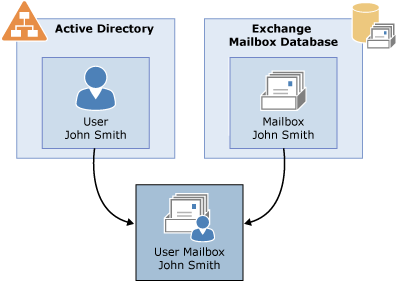An Exchange
mailbox is a composition of a Directory user account and mailbox data stored in
the Exchange mailbox database. The Exchange attributes of Active Directory user
object stores all configuration data for a mailbox. The database of mailbox
contains the mail data that’s in the mailbox associated with the user account.
Following picture
is a representation of mailbox components:
What is a disconnected mailbox?
A disconnected
mailbox is a mailbox object in the mailbox database which is not associated
with an Active Directory user account. These mailboxes are basically of two
types:
a) Disabled mailboxes
b) Soft-deleted mailboxes
a) Disabled mailboxes: When a user
mailbox is disabled or deleted in the EAC (Exchange Administration Center) or
by executing Disable-Mailbox or Remove-Mailbox command in the Exchange
Management shell, Exchange restore the deleted mailbox in the mailbox database
and put the mailbox to a disabled state. These mailboxes referred as disabled mailboxes.
The
difference between disable and deleted mailbox is that, in disable
mailbox, the Exchange attributes are removed from the corresponding Active
Directory user account while in deleted mailbox both the Exchange attribute and
the Active Directory user account are deleted.
NOTE: If the user
mailbox is deleted using a Remove-Mailbox command and either the Permanent or StoreMailboxidentity parameter, it will be deleted from the mailbox
database immediately.
If you want
to find any disabled mailbox in your organization, execute the following
command in the shell:
Get-MailboxDatabase | Get-MailboxStatistics |
Where {$_.DisconnectReason -eq "Disabled" } | ft
DisplayName,Database,DisconnectDate
b) Soft-deleted mailboxes: When a
user mailbox is moved to a different mailbox database, Exchange doesn’t fully
delete the mailbox from source mailbox database. It keeps the mailbox in the
source mailbox database to a soft-deleted
state. These soft-deleted mailboxes can be retained in the source database either
until the deleted mailbox retention period expires or the Remove-StoreMailbox command is executed.
If you wish
to identify the soft-deleted mailboxes in your organization, execute:
Get-MailboxDatabase | Get-MailboxStatistics |
Where {$_.DisconnectReason -eq "SoftDeleted" } | ft
DisplayName,Database,DisconnectDate
Now, the following
is a list of activities which you can perform with disabled and soft-deleted
mailboxes:
1) Working with disabled mailboxes: You canperform many operations on disabled
mailboxes before it get permanently deleted from the mailbox database:
·
You can reconnect
it to the same user account.
·
You can connect it
to a different user account which doesn’t have a mailbox.
·
You can also
restore it to a user account that has an existing mailbox.
·
Permanent deletion
of mailbox can be done from Exchange mailbox database.
2) Working with disabled archive mailboxes: When Archive mailboxes are disabled they become disconnected. You can
connect a disconnected archive mailbox by using Connect-Mailbox command with the Archive parameter. You can perform
two operations on a disconnected archive mailbox as follows:
·
You can connect it
to an existing primary mailbox.
· You can also
permanently delete it from the Exchange mailbox database.
3) Working with soft-deleted mailboxes: When a user mailbox ismoved
from one Exchange mailbox database to another mailbox database, then a
‘soft-deleted’ mailbox is created. However, this mailbox doesn’t get fully deleted
from the source database. And in case the mailbox fails to move to a
destination mailbox. You can restore it back from the source database depending
upon the mailbox retention period.
Following operations can be executed in the soft-deleted mailbox:
·
Restore it to an
existing mailbox.
· These types of
mailboxes can be permanently deleted from the Exchange mailbox database.
So, I believe
this blog gives you the better insight about the relation between the various
components of Exchange Server and what sort of activities you can perform with
those components (mailboxes).
